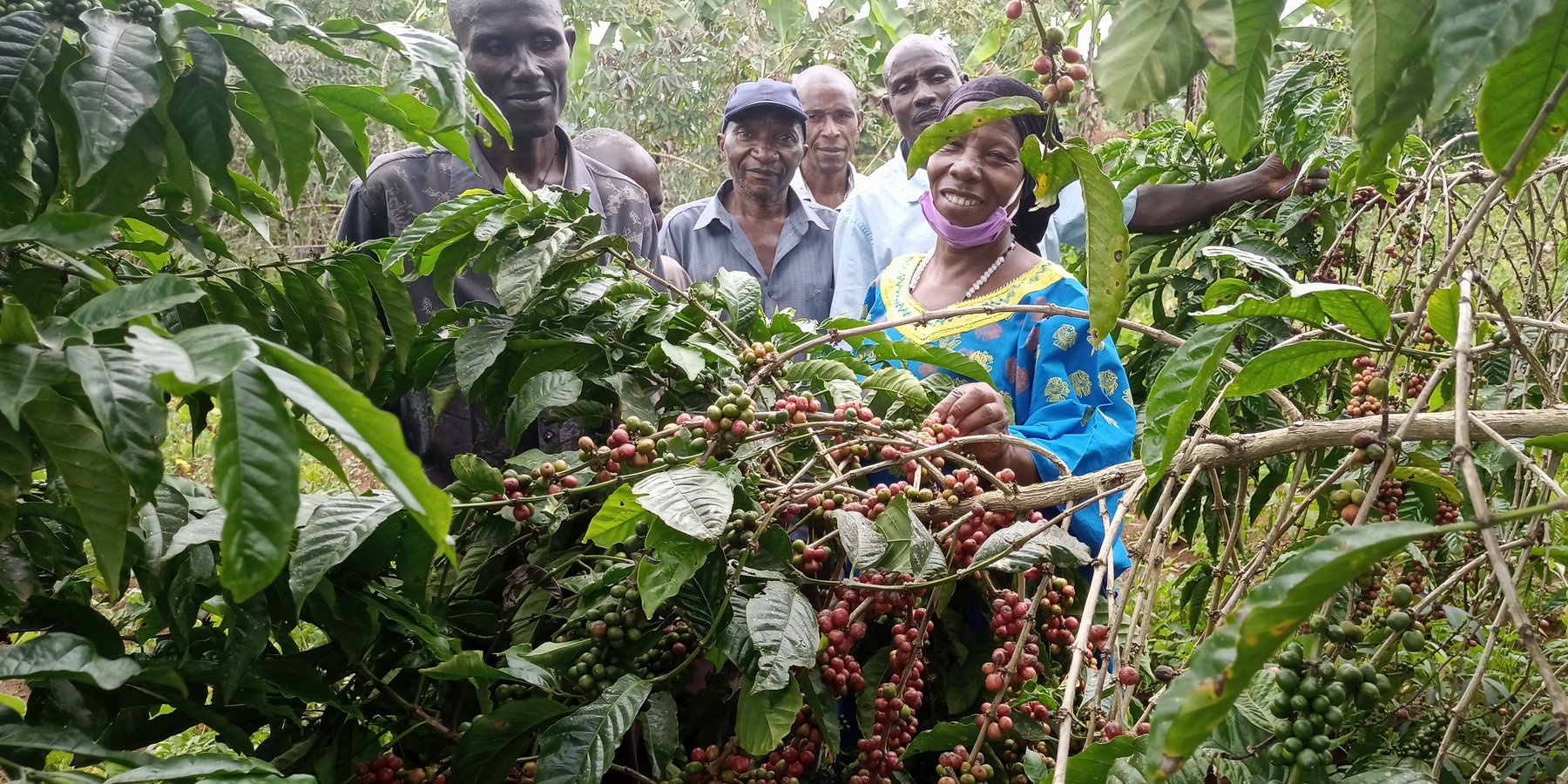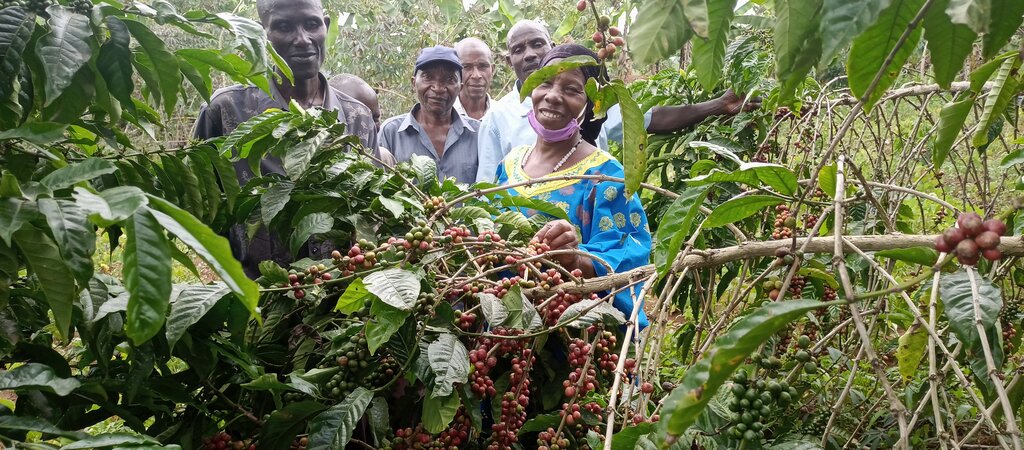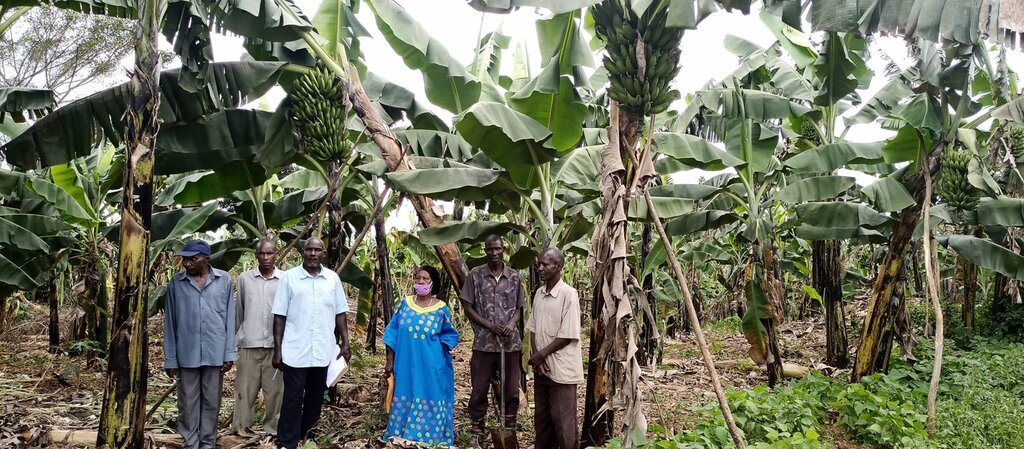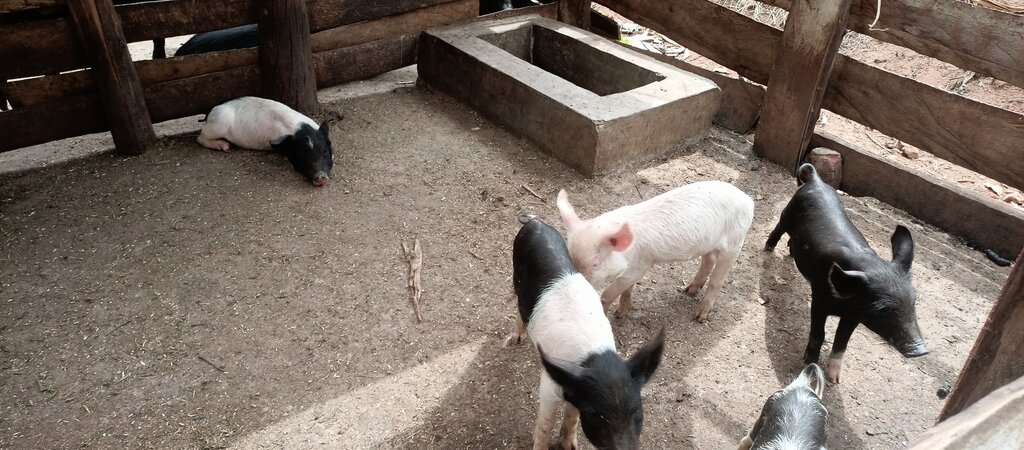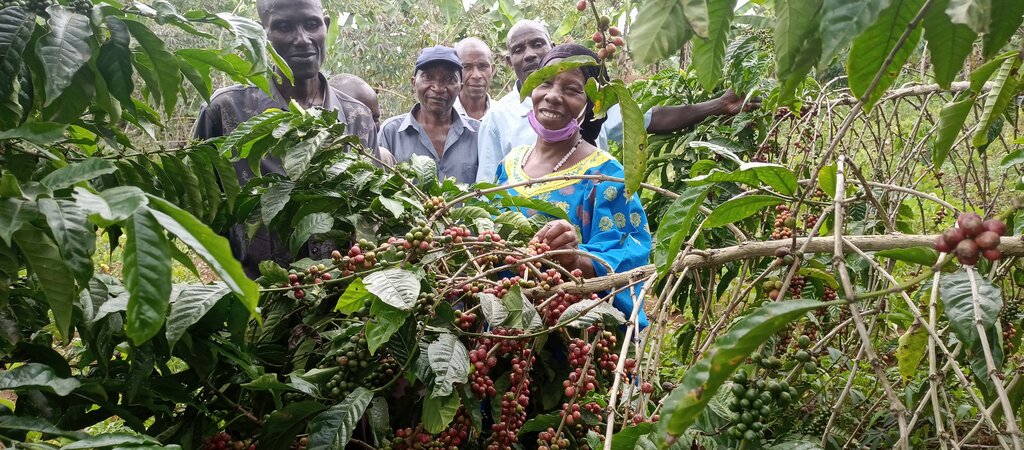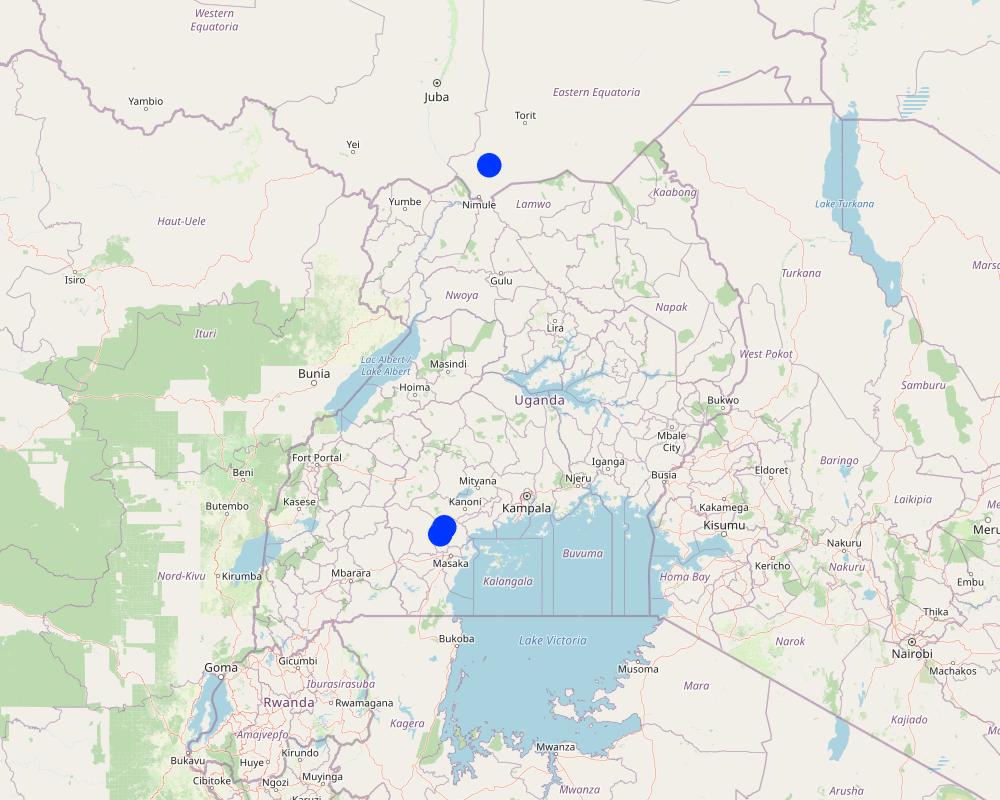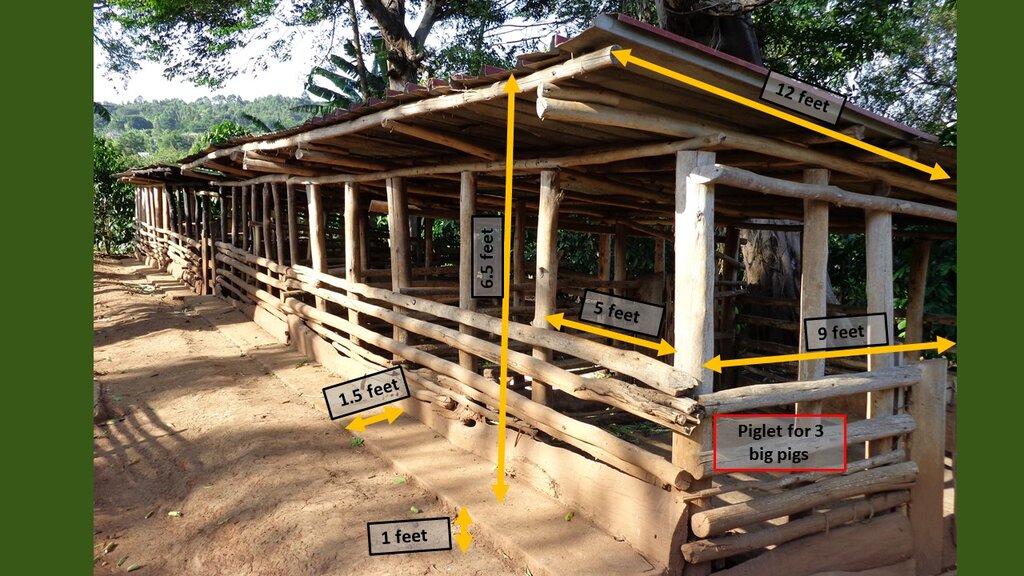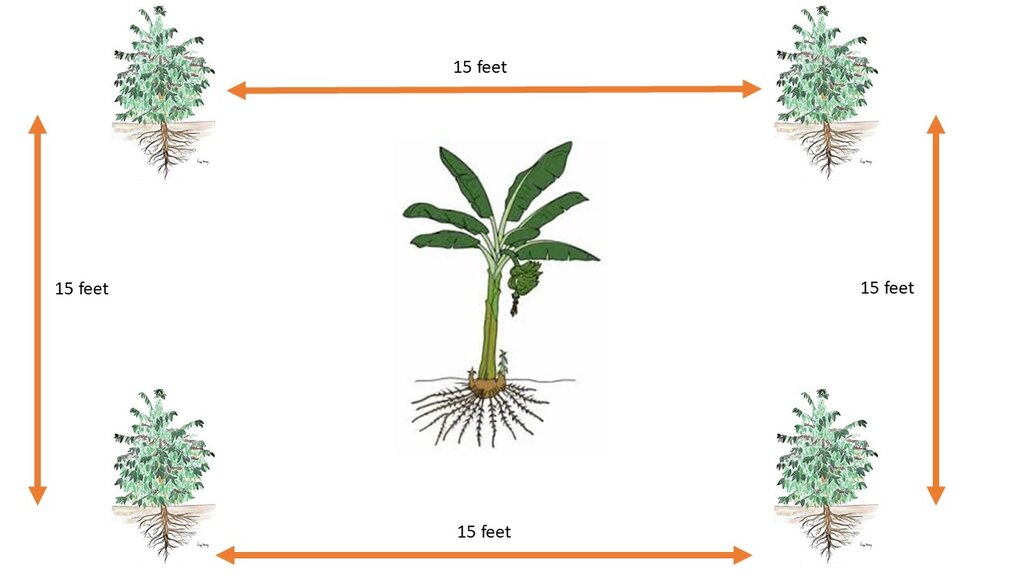Piggery-Banana-Coffee technology [អ៊ូហ្គង់ដា]
- ការបង្កើត៖
- បច្ចុប្បន្នភាព
- អ្នកចងក្រង៖ Tonny Kyambadde
- អ្នកកែសម្រួល៖ Beatrice Nabukenya, Michael Mulindwa, Kyagaba Prossy, Annika Reimann
- អ្នកត្រួតពិនិត្យច្រើនទៀត៖ William Critchley, Rima Mekdaschi Studer
Obusa bwe mbizzi kumwanyi ne bitooke
technologies_5914 - អ៊ូហ្គង់ដា
ពិនិត្យមើលគ្រប់ផ្នែក
ពង្រីកមើលទាំងអស់ បង្រួមទាំងអស់1. ព័ត៌មានទូទៅ
1.2 ព័ត៌មានលម្អិតពីបុគ្គលសំខាន់ៗ និងស្ថាប័នដែលចូលរួមក្នុងការវាយតម្លៃ និងចងក្រងឯកសារនៃបច្ចេកទេស
co-compiler:
Kyagaba Prossy
Caritas MADDO
អ៊ូហ្គង់ដា
co-compiler:
co-compiler:
ឈ្មោះគម្រោងដែលបានចងក្រងឯកសារ/ វាយតម្លៃលើបច្ចេកទេស (បើទាក់ទង)
Euregio-East Africa Livelihood Improvement Programme (EEALIP)ឈ្មោះអង្គភាពមួយ (ច្រើន) ដែលបានចងក្រងឯកសារ/ វាយតម្លៃបច្ចេកទេស (បើទាក់ទង)
Caritas Masaka Diocesan Development Organisation (Caritas MADDO) - អ៊ូហ្គង់ដា1.3 លក្ខខណ្ឌទាក់ទងទៅនឹងការប្រើប្រាស់ទិន្នន័យដែលបានចងក្រងតាមរយៈ វ៉ូខេត
អ្នកចងក្រង និង(បុគ្គលសំខាន់ៗ)យល់ព្រមទទួលយកនូវលក្ខខណ្ឌនានាទាក់ទងទៅនឹងការប្រើប្រាស់ទិន្នន័យដែលបានចងក្រងតាមរយៈវ៉ូខេត:
បាទ/ចា៎
1.4 សេចក្តីប្រកាសស្តីពីចីរភាពនៃការពណ៌នាពីបច្ចេកទេស
តើបច្ចេកទេសដែលបានពណ៌នានេះមានបញ្ហាដែលផ្តោតលើការធ្លាក់ចុះគុណភាពដី, បើដូច្នេះវាមិនអាចត្រូវបានប្រកាសថាជាបច្ចេកទេសនៃការគ្រប់គ្រងប្រកបដោយចីរភាពទេ?
ទេ
មតិយោបល់:
The technology under documentation is practically proven for its efficiency and effectiveness in conserving land and improving productivity.
1.5 ការយោងទៅលើកម្រងបញ្ជីសំណួរ (មួយ ឬច្រើន) នៃវិធីសាស្ត្រផ្សព្វផ្សាយ SLM (ដែលបានចងក្រងដោយទស្សនៈពិភពលោកស្តីពីវិធីសាស្ត្រ និងបច្ចេកទេសងអភិរក្ស WOCAT)
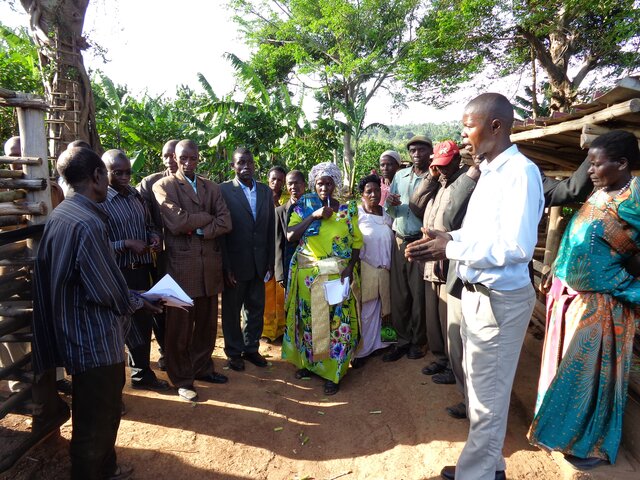
MADDO SLM approach [អ៊ូហ្គង់ដា]
This integrated soil fertility management approach aims at identifying and promoting practices in land management that can increase soil fertility, reduce land degradation and improve production. Under this specific example, organic manure from a piggery was applied to banana and coffee plantations.
- អ្នកចងក្រង៖ Tonny Kyambadde
2. ការពណ៌នាពីបច្ចេកទេស SLM
2.1 ការពណ៌នាដោយសង្ខេបពីបច្ចេកទេស
និយមន័យបច្ចេកទេស:
The "Piggery-Banana-Coffee" sustainable land management technology is a proven practice that significantly improves soil fertility and productivity in an integrated farming system for smallholder farmers in Uganda.
2.2 ការពណ៌នាលម្អិតពីបច្ចេកទេស
ការពណ៌នា:
The “piggery-banana-coffee” SLM technology has been widely practiced by smallholders in Bukumansimbi District, Central Uganda for many years. The technology is proven due to its manifold functions and benefits, including increased productivity and improved soil biodiversity leading to better food security with organic, healthy produce. It simultaneously contributes to environmental protection. The technology has been applied for many years in Bukumansimbi but it needed a promotion by the implementer Caritas MADDO for wider adaption by the community.
The technology can be applied in a natural environmental setting with no controlled conditions. Taking a case of one acre (0.4 ha) of land the farmer will need 450 coffee seedlings and 150 banana suckers to establish an integrated banana-coffee plantation. Then there is a requirement for 10 pigs to supply enough manure (urine and dung) to maintain the fertility of the soil in the plantation. Bananas provide shade to the coffee and reduce the impact of wind and soil erosion. Manure from the piggery is applied to the mixed plantation. Manure application increases soil biodiversity and improves both the physical and chemical properties of the soil, including soil structure, aeration, and moisture retention. Integrating piggery components into the system requires shed construction, purchase of piglets, feeding costs, treatment, and vaccinations. The pigsty occupies a space of 50 ft by 25 ft (approx. 15 m x 7.5 m). Each enterprise is complementary to the other: manure from pigs goes to the coffee and banana plantation and in return the banana peelings as well as the household food leftovers are served as important food resources for the pigs.
The land users under the pilot project acknowledge the significance of the technology because of its ability to sustain production and the other benefits listen above. However, swine fever disease is one of the limiting factors to the technology, as the pigs are prone to its outbreak. Moreover, some farmers report the high feeding costs for the pigs’ maintenance - particularly in the dry season (when there are few weeds that can be supplemented to the diet of the pigs).
2.3 រូបភាពនៃបច្ចេកទេស
2.5 ប្រទេស/តំបន់/ទីតាំងកន្លែង ដែលបច្ចេកទេសត្រូវបានអនុវត្ត និងបានគ្រប់ដណ្តប់ដោយការវាយតម្លៃនេះ
ប្រទេស:
អ៊ូហ្គង់ដា
តំបន់/រដ្ឋ/ខេត្ត:
Central region
បញ្ជាក់បន្ថែមពីលក្ខណៈនៃទីតាំង:
Bigasa Sub County in Bukomansimbi District
បញ្ជាក់ពីការសាយភាយនៃបច្ចេកទេស:
- ត្រូវបានផ្សព្វផ្សាយត្រឹមតំបន់មួយ
ប្រសិនបើមិនច្បាស់ពីទំហំផ្ទៃដី សូមធ្វើការប៉ាន់ប្រម៉ាណ:
- 0.1-1 គម2
តើបច្ចេកទេស (មួយ ឬច្រើន) ទាំងនោះស្ថិតនៅក្នុងតំបន់ការពារជាអចិន្ត្រៃយ៍ណាមួយដែរឬទេ?
ទេ
Map
×2.6 កាលបរិច្ឆេទនៃការអនុវត្ត
បង្ហាញឆ្នាំនៃការចុះអនុវត្ត:
2017
ប្រសិនបើមិនច្បាស់ឆ្នាំ សូមបញ្ជាក់កាលបរិច្ឆេទដែលប្រហាក់ប្រហែល:
- តិចជាង 10ឆ្នាំមុន (ថ្មី)
2.7 ការណែនាំពីបច្ចេកទេស
សូមបញ្ជាក់តើបច្ចេកទេសត្រូវបានណែនាំឱ្យអនុវត្តដោយរបៀបណា:
- ជាផ្នែកនៃប្រព័ន្ធប្រពៃណី (> 50 ឆ្នាំ)
- តាមរយៈគម្រោង / អន្តរាគមន៍ពីខាងក្រៅ
មតិយោបល់ (ប្រភេទនៃគម្រោង ។ល។):
The "piggery-banana-coffee” SLM technology has been practiced as a traditional system in the area for more than 50 years, however the project rebooted the technology and its adoption under the EEALIP project starting in 2017.
3. ចំណាត់ថ្នាក់នៃបច្ចេកទេស SLM
3.1 គោលបំណងចម្បង (១ ឬច្រើន) នៃបច្ចេកទេសនេះ
- ធ្វើឱ្យប្រសើរឡើងនូវផលិតកម្ម
- កាត់បន្ថយ, បង្ការ, ស្តារឡើងវិញនូវការធ្លាក់ចុះគុណភាពដី
- អភិរក្សប្រព័ន្ធអេកូឡូស៊ី
- អភិរក្ស/ធ្វើឱ្យប្រសើរឡើងជីវចម្រុះ
- បង្កើតផលប្រយោជន៍សេដ្ឋកិច្ច
3.2 ប្រភេទដីប្រើប្រាស់មួយប្រភេទ (ច្រើនប្រភេទ) ដែលបានអនុវត្តបច្ចេកទេស
ដីប្រើប្រាស់ចម្រុះនៅលើដីតែមួយ:
បាទ/ចា៎
បញ្ជាក់ពីប្រភេទដីច្រើនប្រភេទ (ដីដាំដំណាំ/ដីចិញ្ចឹមសត្វ/ដីព្រៃឈើ):
- កសិរុក្ខកម្ម

ដីដាំដំណាំ
- ដំណាំរយៈពេលវែង (មិនមែនឈើ)
ដំណាំរយៈពេលវែង (មិនមែនឈើ) - បញ្ជាក់ប្រភេទដំណាំ:
- ចេក/plantain/abaca
- Coffee
ចំនួនសារដែលដាំដំណាំក្នុងមួយឆ្នាំ:
- 2
សូមបញ្ជាក់:
For banana the harvest is continuous through the year whiles as coffee has two harvesting seasons
តើជាការអនុវត្តន៍ដំណាំចន្លោះ?
បាទ/ចា៎
ប្រសិនបើបាទ/ច៎ា សូមបញ្ជាក់ប្រភេទដំណាំដែលដាំចន្លោះគ្នានោះ:
Banana and coffee are intercropped
តើជាការអនុវត្តន៍ដំណាំវិលជុំ?
ទេ

ដីព្រៃ/ដីដាំដើមឈើ
- ការដាំដើមឈើ ការដាំព្រៃឡើងវិញ
ការដាំដើមឈើ ការដាំដើមឈើឡើងវិញ៖ បញ្ជាក់ពីប្រភេទក្នុងតំបន់ និងប្រភេទលុប:
- ពូជបញ្ចូលគ្នា
- Ficus natalensis (mutuba in luganda) tree
តើប្រភេទឈើខាងលើជាប្រភេទឈើក្នុងព្រៃល្បោះ ឬស្រោង?
- ព្រៃស្រោង
ផលិតផល និងសេវាកម្ម:
- ឈើហ៊ុប
- អុស
- ផលិតផលព្រៃផ្សេងៗ
- វាលស្មៅ
- ការអភិរក្ស/ការការពារធម្មជាតិ
- ការកំសាន្ត/ទេសចរណ៍
- ការពារពីគ្រោះធម្មជាតិ
- Backcloth

ផ្លូវទឹក ផ្ទៃទឹក ដីសើម
- វាលភក់ ដីសើម
ផលិតផល/សេវាកម្មចម្បង:
Swamp is nearby for water supply
3.3 បន្ទាប់ពីអនុវត្តបច្ចេកទេស តើដីប្រើប្រាស់មានការប្រែប្រួលដែររឺទេ?
បន្ទាប់ពីអនុវត្តបច្ចេកទេស តើដីប្រើប្រាស់មានការប្រែប្រួលដែររឺទេ?
- បាទ/ច៎ា (សូមបំពេញសំណួរខាងក្រោមពីស្ថានភាពដីប្រើប្រាស់មុនពេលអនុវត្តបច្ចេកទេស)
ដីប្រើប្រាស់ចម្រុះនៅលើដីតែមួយ:
បាទ/ចា៎
បញ្ជាក់ពីប្រភេទដីច្រើនប្រភេទ (ដីដាំដំណាំ/ដីចិញ្ចឹមសត្វ/ដីព្រៃឈើ):
- ដាំដំណាំ ចិញ្ចឹមសត្វ និងឈើ

ដីដាំដំណាំ
- ដំណាំរយៈពេលវែង (មិនមែនឈើ)
ដំណាំរយៈពេលវែង (មិនមែនឈើ) - បញ្ជាក់ប្រភេទដំណាំ:
- ចេក/plantain/abaca
- coffee
តើជាការអនុវត្តន៍ដំណាំចន្លោះ?
បាទ/ចា៎
ប្រសិនបើបាទ/ច៎ា សូមបញ្ជាក់ប្រភេទដំណាំដែលដាំចន្លោះគ្នានោះ:
Banana and coffee are intercropped
តើជាការអនុវត្តន៍ដំណាំវិលជុំ?
ទេ

ដីព្រៃ/ដីដាំដើមឈើ
- ការដាំដើមឈើ ការដាំព្រៃឡើងវិញ
ការដាំដើមឈើ ការដាំដើមឈើឡើងវិញ៖ បញ្ជាក់ពីប្រភេទក្នុងតំបន់ និងប្រភេទលុប:
- ពូជបញ្ចូលគ្នា
- Ficus natalensis (mutuba in luganda) tree
តើប្រភេទឈើខាងលើជាប្រភេទឈើក្នុងព្រៃល្បោះ ឬស្រោង?
- ព្រៃស្រោង
ផលិតផល និងសេវាកម្ម:
- ឈើហ៊ុប
- អុស
- ផលិតផលព្រៃផ្សេងៗ
- វាលស្មៅ
- ការអភិរក្ស/ការការពារធម្មជាតិ
- ការកំសាន្ត/ទេសចរណ៍
- ការពារពីគ្រោះធម្មជាតិ

ផ្លូវទឹក ផ្ទៃទឹក ដីសើម
- វាលភក់ ដីសើម
ផលិតផល/សេវាកម្មចម្បង:
Swamp is nearby for water supply
មតិយោបល់:
Pigs are kept on zero grazing. There are not allowed to roam in the bananas or coffee farm.
3.4 ការផ្គត់ផ្គង់ទឹក
ការផ្គត់ផ្គង់ទឹកនៅកន្លែងអនុវត្តបច្ចេកទេស:
- ទឹកភ្លៀង
មតិយោបល់:
The land is mulched with dry grass and banana materials to conserve rainfed water from evaporation.
3.5 ក្រុម SLM ដែលបច្ចេកទេសស្ថិតនៅក្នុង
- កសិរុក្ខកម្ម
- ការគ្រប់គ្រងដោយរួមបញ្ចូលការដាំដំណាំ និងការចិញ្ចឹមសត្វ
- ការគ្រប់គ្រងជីជាតិដីតាមបែបចម្រុះ
3.6 វិធានការ SLM ដែលបញ្ចូលនូវបច្ចេកទេស

វិធានការក្សេត្រសាស្ត្រ
- A1: ដំណាំ/គម្របដី
- A2: សារធាតុសរីរាង្គ/ជីជាតិដី
- A3: ការរក្សាស្រទាប់ដីខាងលើ
- A7: ផ្សេងៗ
A3: ប្រព័ន្ធភ្ជួររាស់ខុសៗគ្នា:
A 3.2: Reduced tillage (> 30% soil cover)

វិធានការរុក្ខជាតិ
- V1: ឈើធំៗ និងដើមឈើតូចៗ
- V2: ស្មៅនិងរុក្ខជាតិៗដែលដុះមានអាយុមិនលើសពី 2ឆ្នាំ
- V3: ការកាប់ឆ្ការរុក្ខជាតិ

វិធានការរចនាស័ម្ពន្ធ
- S1: ការធ្វើដីថ្នាក់ៗតាមជម្រាលភ្នំ
- S9: រោងដំណាំ និងរោងចិញ្ចឹមសត្វ
3.7 កំណត់ប្រភេទនៃការធ្លាក់ចុះគុណភាពដីសំខាន់ៗដែលបច្ចេកទេសនេះបានដោះស្រាយ

ការហូរច្រោះដីដោយសារទឹក
- Wt: ការបាត់ដីស្រទាប់លើដោយការហូរច្រោះ
- Wo: ផលប៉ះពាល់នៃការធ្លាក់ចុះគុណភាពកន្លែងឆ្ងាយ

ការធ្លាក់ចុះសារធាតុគីមីក្នុងដី
- Cp: ការបំពុលដី

ការធ្លាក់ចុះជីវសាស្ត្រនៃដី
- Bq: ការថយចុះនូវជីវម៉ាស/ បរិមាណ
- Bs: សមាសភាពដែលមានគុណភាពនិងប្រភេទសត្វ/ការថយចុះនូវជីវចម្រុះ
- Bl: ការបាត់បង់មីក្រូ និងម៉ាក្រូសរីរាង្គរបស់ដី
- Bp: ការកើនឡើងនូវសត្វល្អិត ឬជំងឺ បាត់បង់នូវសត្វមានប្រយោជន៍

ការបាត់បង់ទឹក
- Hq: ការថយចុះគុណភាពទឹកនៅក្រោមដី
មតិយោបល់:
The technology is promoting better quality of groundwater on two grounds. Firstly, by applying the organic manure of the pigs on the coffee and banana farm instead of chemical fertilizers no pollution of the waterbodies is given. Secondly, the pigs are confined in their pigs sty and thus due not have the opportunity to go to the water bodies and pollute the water with urine or dung.
3.8 ការពារ កាត់បន្ថយ ឬស្តារឡើងវិញនៃការធ្លាក់ចុះគុណភាពដី
បញ្ជាក់ពីគោលដៅរបស់បច្ចេកទេស ដែលផ្តោតទៅការធ្លាក់ចុះគុណភាពដី:
- ការការពារការធ្លាក់ចុះគុណភាពដី
- ការកាត់បន្ថយការធ្លាក់ចុះគុណភាពដី
មតិយោបល់:
The major purpose for this technology is to prevent soil degradation and improve soil fertility.
4. បច្ចេកទេសជាក់លាក់ សកម្មភាពអនុវត្ត ធាតុចូល និងថ្លៃដើម
4.1 គំនូសបច្ចេកទេសនៃបច្ចេកទេសនេះ
លក្ខណៈពិសេសនៃបច្ចេកទេស (ទាក់ទងនឺងគំនូរបច្ចេកទេស):
Technical specifications of the pig sty construction
ឈ្មោះអ្នកនិពន្ធ:
Kyambadde, Tonny
កាលបរិច្ឆេទ:
19/04/2021
លក្ខណៈពិសេសនៃបច្ចេកទេស (ទាក់ទងនឺងគំនូរបច្ចេកទេស):
Technical specifications of the coffee and banana integration
ឈ្មោះអ្នកនិពន្ធ:
Kyambadde, Tonny
កាលបរិច្ឆេទ:
13/07/2023
4.2 ព័ត៌មានទូទៅដែលពាក់ព័ន្ធនឹងការគណនាធាតុចូល និងថ្លៃដើម
កំណត់របៀបនៃការគណនាថ្លៃដើម និងធាតុចូល:
- ក្នុងតំបន់អនុវត្តបច្ចេកទេស
កំណត់ទំហំ និងឯកត្តាផ្ទៃដី:
one hectare
ផ្សេងៗ/ រូបិយប័ណ្ណជាតិ (បញ្ជាក់):
Uganda Shilling
បើពាក់ព័ន្ធសូមកំណត់អត្រាប្តូរប្រាក់ពីដុល្លាទៅរូបិយប័ណ្ណតំបន់ (ឧ. 1 ដុល្លារ = 79.9 រៀលនៃរូបិយប័ណ្ណប្រេស៊ីល) ៖ 1 ដុល្លារ =:
3750,0
កំណត់ថ្លៃឈ្នួលជាមធ្យមនៃការជួលកម្លាំងពលកម្មក្នុងមួយថ្ងៃ:
no labour was hired
4.3 សកម្មភាពបង្កើត
| សកម្មភាព | រយៈពេល (រដូវកាល) | |
|---|---|---|
| 1. | Land clearing and preparation | once a year |
| 2. | Hole digging | once |
| 3. | Coffee and banana planting | once |
| 4. | Pig sty (house) construction | once |
| 5. | Purchase of pigs | once |
4.4 ថ្លៃដើម និងធាតុចូលដែលត្រូវការសម្រាប់ការបង្កើតបច្ចេកទេស
ប្រសិនបើមិនអាចបំបែកតម្លៃដើមក្នុងតារាងខាងក្រោមទេ សូមផ្តល់នូវតម្លៃប៉ាន់ស្មានសរុបក្នុងការបង្កើតបច្ចេកទេសនោះ:
5300000,0
ប្រសិនបើអ្នកប្រើប្រាស់ដីមិនមានថ្លៃដើម 100% សូមបញ្ជាក់ថានរណាដែលចំណាយថ្លៃដើមដែលនៅសល់:
The Euregio project contributed two pigs and some starter coffee seedlings and banana suckers (roughly 35 % of total establishment costs were catered by the project).
មតិយោបល់:
These costs include the clearing of the land and prior establishment of the coffee and banana plantation. The majority of the costs are attributed to the purchase of pigs and the construction of the pig sty (roughly 3 million UGX).
4.5 សកម្មភាពថែទាំ
| សកម្មភាព | ពេលវេលា/ ភាពញឹកញាប់ | |
|---|---|---|
| 1. | Weeding and garden clearing | Twice a seaon |
| 2. | Manure application | At the onset of rain season |
| 3. | Feeding and watering of pigs | On daily basis |
| 4. | Treatment and deworming of pigs | On monthly basis |
| 5. | Mulching of the garden | Once a year or more |
| 6. | Contour digging | once a year |
| 7. | Pruning of coffee and banana plantation | For banana its done twice a season and for coffee its done every after harvesting season. |
| 8. | Maintenance of piggery sty | once a year |
4.6 កំណត់ថ្លៃដើមសម្រាប់ការថែទាំ/ សកម្មភាពរបស់បច្ចេកទេស (ក្នុងរយៈពេលមួយឆ្នាំ)
ប្រសិនបើមិនអាចបំបែកតម្លៃដើមក្នុងតារាងខាងក្រោមទេ សូមផ្តល់នូវតម្លៃប៉ាន់ស្មានសរុបក្នុងការថែទាំបច្ចេកទេសនោះ:
500000,0
មតិយោបល់:
Estimation of 500,000 UGX per year. Most costs are for the treatment for the pigs and the maintenance of the pigsty. The rest is covered by family labour.
4.7 កត្តាសំខាន់បំផុតដែលមានឥទ្ធិពលដល់ការចំណាយ
ពណ៌នាពីកត្តាប៉ះពាល់ចម្បងៗទៅលើថ្លៃដើម:
Most costs are connected to the piggery in particular the maintenance of the pigs. Animal diseases and the resulting costs for the treatments are unplanned expenses.
5. លក្ខណៈបរិស្ថានធម្មជាតិ និងមនុស្ស
5.1 អាកាសធាតុ
បរិមាណទឹកភ្លៀងប្រចាំឆ្នាំ
- < 250 មម
- 251-500 មម
- 501-750 មម
- 751-1,000 មម
- 1,001-1,500 មម
- 1,501-2,000 មម
- 2,001-3,000 មម
- 3,001-4,000 មម
- > 4,000 មម
កំណត់បរិមាណទឹកភ្លៀង (បើដឹង) ជា មីលីម៉ែត្រ:
1200,00
លក្ខណៈពិសេស/ មតិយោបល់លើរដូវភ្លៀង:
The rainfall pattern is bimodal, having two seasons. The two dry spell seasons are between January - March and between June to August, with the winter seasons between March to May and September to December.
បញ្ជាក់ឈ្មោះឯកសារយោងនៃស្ថានីយឧតុនិយម:
Uganda metrological authority
តំបន់កសិអាកាសធាតុ
- មានភ្លៀងមធ្យម
The average maximum temperature doesn't exceed 30 degrees Celcius and the minimum temperature is not below 10 degrees Celcius with almost equal length of the day and night through out the year.
The humidity level is relatively low through out the area.
5.2 សណ្ឋានដី
ជម្រាលជាមធ្យម:
- រាបស្មើ (0-2%)
- ជម្រាលតិចតួច (3-5%)
- មធ្យម (6-10%)
- ជម្រាលខ្ពស់បន្តិច (11-15%)
- ទីទួល (16-30%)
- ទីទួលចោត (31-60%)
- ទីទួលចោតខ្លាំង (>60%)
ទម្រង់ដី:
- ខ្ពង់រាប
- កំពូលភ្នំ
- ជម្រាលភ្នំ
- ជម្រាលទួល
- ជម្រាលជើងភ្នំ
- បាតជ្រលងភ្នំ
តំបន់តាមរយៈកម្ពស់ :
- 0-100 ម
- 101-500 ម
- 501-1,000 ម
- 1,001-1,500 ម
- 1,501-2,000 ម
- 2,001-2,500 ម
- 2,501-3,000 ម
- 3,001-4,000 ម
- > 4,000 ម
5.3 ដី
ជម្រៅដីជាមធ្យម:
- រាក់ខ្លាំង (0-20 សម)
- រាក់ (21-50 សម)
- មធ្យម (51-80 សម)
- ជ្រៅ (81-120 សម)
- ជ្រៅខ្លាំង (> 120 សម)
វាយនភាពដី (ស្រទាប់លើ):
- មធ្យម (ល្បាយ, ល្បាប់)
វាយនភាពដី (> 20 សម ស្រទាប់ក្នុង):
- មធ្យម (ល្បាយ, ល្បាប់)
សារធាតុសរីរាង្គនៅស្រទាប់ដីខាងលើ:
- មធ្យម (1-3%)
បើអាចសូមភ្ជាប់ការពណ៌នាពីដីឱ្យបានច្បាស់ ឬព័ត៌មានដែលអាចទទួលបាន ឧ. ប្រភេទដី, pH ដី/ ជាតិអាស៊ីត, សមត្ថភាពផ្លាស់ប្តូរកាចុង, វត្តមាននីត្រូសែន, ភាពប្រៃ ។ល។:
The soils ranging from red laterite, sandy loam and loam.
Soils are generally ferrallisol characterized by red colored sandy clay loams and sandy loams, but relatively productive.
5.4 ទឹកដែលអាចទាញមកប្រើប្រាស់បាន និងគុណភាពទឹក
នីវ៉ូទឹកក្រោមដី:
5-50 ម
ទឹកលើដីដែលអាចទាញយកប្រើប្រាស់បាន:
កម្រិតមធ្យម
គុណភាពទឹក (មិនបានធ្វើប្រត្តិកម្ម):
ទឹកពិសារដែលគ្មានគុណភាព (តម្រូវឱ្យមានការសំអាត)
គុណភាពទឹក គឺផ្តោតទៅលើ៖:
ទាំងទឹកក្រោមដី និងលើផ្ទៃដី
តើមានបញ្ហាភាពទឹកប្រៃហូរចូលមកដែរឬទេ?
ទេ
តើទឹកជំនន់កំពុងកើតមាននៅតំបន់នេះដែររឺទេ?
ទេ
មតិយោបល់ និងលក្ខណៈពិសេសផ្សេងៗទៀតលើគុណភាព និងបរិមាណទឹក :
Major source of water supply is swamp and readily available all the time in both seasons dry and rain season
5.5 ជីវៈចម្រុះ
ភាពសម្បូរបែបនៃប្រភេទ:
- ខ្ពស់
ភាពសម្បូរបែបនៃទីជម្រក:
- កម្រិតមធ្យម
មតិយោបល់ និងលក្ខណៈពិសេសផ្សេងទៀតលើជីវចម្រុះ:
No official statistics available, but Banana plantations usually have higher diversity with up to 15 species of other crops within.
5.6 លក្ខណៈនៃអ្នកប្រើប្រាស់ដីដែលអនុវត្តបច្ចេកទេស
នៅមួយកន្លែង ឬពនេចរ :
- នៅមួយកន្លែង
ទីផ្សារនៃប្រព័ន្ធផលិតកម្ម:
- ពាក់កណ្តាលពាណិជ្ជកម្ម (ផ្គត់ផ្គង់ខ្លួនឯង/ ពាណិជ្ជកម្ម)
- ពាណិជ្ជកម្ម/ ទីផ្សារ
ចំណូលក្រៅកសិកម្ម:
- តិចជាង 10% នៃចំណូល
កម្រិតជីវភាព:
- មិនល្អ
ឯកជន ឬក្រុម:
- ជាក្រុម/ សហគមន៍
កម្រិតប្រើប្រាស់គ្រឿងយន្ត:
- ប្រើកម្លាំងពលកម្ម
យេនឌ័រ:
- ស្ត្រី
- បុរស
អាយុរបស់អ្នកប្រើប្រាស់ដី:
- យុវវ័យ
- វ័យកណ្តាល
- មនុស្សចាស់
5.7 ទំហំផ្ទៃដីជាមធ្យមនៃដីប្រើប្រាស់ដោយអ្នកប្រើប្រាស់ដី ក្នុងការអនុវត្តបច្ចេកទេស
- < 0.5 ហិកតា
- 0.5-1 ហិកតា
- 1-2 ហិកតា
- 2-5 ហិកតា
- 5-15 ហិកតា
- 15-50 ហិកតា
- 50-100 ហិកតា
- 100-500 ហិកតា
- 500-1,000 ហិកតា
- 1,000-10,000 ហិកតា
- > 10,000 ហិកតា
តើផ្ទៃដីនេះចាត់ទុកជាទំហំកម្រិតណាដែរ ខ្នាតតូច មធ្យម ឬខ្នាតធំ (ធៀបនឹងបរិបទតំបន់)?
- ខ្នាតតូច
មតិយោបល់:
In Central Uganda 1-2 ha is considered small scale. It might be different in other regions of Uganda.
5.8 ភាពជាម្ចាស់ដី កម្មសិទ្ធប្រើប្រាស់ដី និងកម្មសិទ្ធប្រើប្រាស់ទឹក
ភាពជាម្ចាស់ដី:
- ឯកជន មិនមានកម្មសិទ្ធ
- ឯកជន មានកម្មសិទ្ធ
កម្មសិទ្ធិប្រើប្រាស់ដី:
- ឯកជន
កម្មសិទ្ធប្រើប្រាស់ទឹក:
- អាស្រ័យផលសេរី (មិនមានការកំណត់)
តើកម្មសិទ្ធប្រើប្រាស់ដី គឺផ្អែកលើប្រព័ន្ធច្បាប់បែបបុរាណ?
បាទ/ចា៎
5.9 ការប្រើប្រាស់សេវាកម្ម និងហេដ្ឋារចនាសម្ព័ន្ធ
សុខភាព:
- មិនល្អ
- មធ្យម
- ល្អ
ការអប់រំ:
- មិនល្អ
- មធ្យម
- ល្អ
ជំនួយបច្ចេកទេស:
- មិនល្អ
- មធ្យម
- ល្អ
ការងារ (ឧ. ការងារក្រៅកសិដ្ឋាន):
- មិនល្អ
- មធ្យម
- ល្អ
ទីផ្សារ:
- មិនល្អ
- មធ្យម
- ល្អ
ថាមពល:
- មិនល្អ
- មធ្យម
- ល្អ
ផ្លូវ និងការដឹកជញ្ជូន:
- មិនល្អ
- មធ្យម
- ល្អ
ទឹកផឹក និងអនាម័យ:
- មិនល្អ
- មធ្យម
- ល្អ
សេវាកម្មហិរញ្ញវត្ថុ:
- មិនល្អ
- មធ្យម
- ល្អ
6. ផលប៉ះពាល់ និងការសន្និដ្ឋាន
6.1 ផលប៉ះពាល់ក្នុងបរិវេណអនុវត្តបច្ចេកទេសដែលកើតមាន
ផលប៉ះពាល់លើសេដ្ឋកិច្ចសង្គម
ផលិតផល
ផលិតកម្មដំណាំ
គុណភាពមុន SLM:
1
គុណភាពក្រោយ SLM:
3
មតិយោបល់/ ការបញ្ជាក់:
Significant improvement in coffee production was noticed jumping from an average yield increase of 300kg to 700kg of coffee harvest in one acre per season. Size of banana bunches with an average increase in weight from from 12kg to 30kg.
គុណភាពដំណាំ
គុណភាពមុន SLM:
0
គុណភាពក្រោយ SLM:
2
មតិយោបល់/ ការបញ្ជាក់:
Coffee beans improved a lot in terms of size and quality, with over 70% coffee beans harvested in the category of screen 18 (super beans). The banana size and its fingers improved in size, and the taste of banana food greatly improve with a pleasant aroma, softer on eating and cooks faster compared to previously produced bananas.
ផលិតកម្មសត្វ
មតិយោបល់/ ការបញ្ជាក់:
The production of pigs increased substantially in a time period of a year. The participating farmers started with 3 pigs at the beginning and reached an increase of pigs to an average 15 pigs after a year (2 breeding cycles per pig per year).
ការគ្រប់គ្រងដី
គុណភាពមុន SLM:
-2
គុណភាពក្រោយ SLM:
3
មតិយោបល់/ ការបញ្ជាក់:
The farming system employed by the farmers previously before introduction of the technology was not sustainable. Resources were being continuously depleted by crop practices employed without replacement of what is lost from the soil during harvest. integration of piggery into the system improved soil fertility with manure composted from piggery wastes. Besides boosting soil fertility, biodiversity on the farm improved as well (the soil organisms, new plant species emerged, insect species among others) the green biomass and overall soil health improved.
ចំណូល និងថ្លៃដើម
ចំណូលក្នុងកសិដ្ឋាន
មតិយោបល់/ ការបញ្ជាក់:
The average farm income before the technology was very little and did not support the family's basic home needs. With the introduction of the technology, the household income improved from an average of monthly 45.000 UGX to 150.000 UGX. However, it is important to note that this is not a fixed monthly income and is depending on the harvest season. Thus, there are peak income phases followed by low seasons.
ភាពសម្បូរបែបប្រភពប្រាក់ចំណូល
មតិយោបល់/ ការបញ្ជាក់:
More income sources were established through the three enterprises (coffee, banana and piggery).
ផលប៉ះពាល់ទៅលើវប្បធម៌សង្គម
សន្តិសុខស្បៀង/ ភាពគ្រប់គ្រាន់ខ្លួនឯង
គុណភាពមុន SLM:
0
គុណភាពក្រោយ SLM:
2
មតិយោបល់/ ការបញ្ជាក់:
With improved soil fertility resulting in bigger sizes of banana bunches, improved food security was achieved. The increased income from coffee and piggery ensured availability of alternative food supply though their sale.
ស្ថានភាពសុខភាព
គុណភាពមុន SLM:
-1
គុណភាពក្រោយ SLM:
2
មតិយោបល់/ ការបញ្ជាក់:
There was less exposure to agriculture chemical by farmers and the entire community at large which poses health threat to the people and cause environment damage. the quality of food produced was free from any chemical residues emanating from synthetic fertilizers.
ចំណេះដឹង SLM / ការធ្លាក់ចុះគុណភាពដី
មតិយោបល់/ ការបញ្ជាក់:
Through the technology farmers were able to learn how important it is to use organic sources of fertilizer and its benefits to the environment and soil health. MADDO facilitated roughly 15 different training sessions for the participating farmer group targeting the soil and water conservation practices.
ស្ថានភាពក្រុមដែលមានបញ្ហាក្នុងសង្គម និងសេដ្ឋកិច្ច
មតិយោបល់/ ការបញ្ជាក់:
The situation of women (average between 40-55 years old) was improved through the technology by giving them access and knowledge to this pilot project. The mobilization and right selection of participants were crucial for the improvement.
ផលប៉ះពាល់ទៅលើអេកូឡូស៊ី
ដី
សំណើមដី
មតិយោបល់/ ការបញ្ជាក់:
Higher retention of soil moisture
សារធាតុសរីរាង្គដី/ការបូនក្រោមដី
មតិយោបល់/ ការបញ្ជាក់:
Better composition of soil nutrients with increased population of soil organisms (micro and macro)
ជីវចម្រុះ៖ ដំណាំ, សត្វ
ជីវម៉ាស/ កាបូនលើដី
ភាពសម្បូរបែបនៃទីជំរក
មតិយោបល់/ ការបញ្ជាក់:
Organic manure provided a conducive environment for multiplication and survival of living organisms
បញ្ជាក់ពីការប៉ាន់ស្មាននៃផលប៉ះពាល់ក្នុងបរិវេណអនុវត្តបច្ចេកទេស (វាស់វែង):
All the impacts are based on estimations. Thereby, assessments by farmers have been added with observations from the staff to get a clear understanding of the impacts.
6.2 ផលប៉ះពាល់ក្រៅបរិវេណអនុវត្តបច្ចេកទេសដែលកើតមាន
Pollution of water
មតិយោបល់/ ការបញ្ជាក់:
The usage of organic manure instead of chemical fertilizers reduced the pollution of downstream water from fields
វាយតម្លៃផលប៉ះពាល់ក្រៅបរិវេណអនុវត្តបច្ចេកទេស (វាស់វែង):
This impact is based on estimation by the project staff as well as some observations from participants.
6.3 ភាពប្រឈម និងភាពរួសនៃបច្ចេកទេសទៅនឹងការប្រែប្រួលអាកាសធាតុ និងគ្រោះអាកាសធាតុ/ គ្រោះមហន្តរាយ (ដែលដឹងដោយអ្នកប្រើប្រាស់ដី)
មតិយោបល់:
The technology was piloted in a 3-year program and climate-related consequences cannot be measured yet.
6.4 ការវិភាគថ្លៃដើម និងអត្ថប្រយោជន៍
តើផលចំណេញ និងថ្លៃដើមត្រូវបានប្រៀបធៀបគ្នាយ៉ាងដូចម្តេច (ទស្សនៈរបស់អ្នកប្រើប្រាស់ដី)?
រយៈពេលខ្លី:
វិជ្ជមាន
រយៈពេលវែង:
វិជ្ជមានខ្លាំង
តើផលចំណេញ និងការថែទាំ/ ជួសជុលត្រូវបានប្រៀបធៀបគ្នាយ៉ាងដូចម្តេច (ទស្សនៈរបស់អ្នកប្រើប្រាស់ដី)?
រយៈពេលខ្លី:
វិជ្ជមាន
រយៈពេលវែង:
វិជ្ជមានតិចតួច
មតិយោបល់:
After the establishment of the technology, the returns from coffee are attained in period of two years, for banana returns observed in less than one year and for piggery profits attained in period of less than two years.
6.5 ការទទួលយកបច្ចេកទេស
- 11-50%
បើអាច សូមបញ្ជាក់ពីបរិមាណ (ចំនួនគ្រួសារ និង/ ឬតំបន់គ្របដណ្តប់):
Mainstreaming of the technology was promoted through copying from the participants and also due to the promotion by the district field staff. The technology has been in existence for years and that is why a high adoption can be observed.
ក្នុងចំណោមគ្រួសារទាំងអស់ដែលបានអនុវត្តបច្ចេកទេស តើមានប៉ុន្មានគ្រួសារដែលចង់ធ្វើដោយខ្លួនឯង ដោយមិនទទួលបានសម្ភារៈលើកទឹកចិត្ត/ប្រាក់ឧបត្ថម្ភ?:
- 51-90%
មតិយោបល់:
The technology is commonly used in the area. However, those who were not part of the program take short-cuts or do not have such high positive progress as the others.
6.6 ការបន្សុំា
តើថ្មីៗនេះ បច្ចេកទេសនេះត្រូវបានកែតម្រូវដើម្បីបន្ស៊ាំទៅនឹងស្ថានភាពប្រែប្រួលដែរឬទេ?
ទេ
6.7 ភាពខ្លាំង/ គុណសម្បត្តិ/ ឱកាសនៃបច្ចេកទេស
| ភាពខ្លាំង/ គុណសម្បត្តិ/ ឱកាសនៅកន្លែងរបស់អ្នកប្រើប្រាស់ដី |
|---|
| Contributes positively to the soil fertility. |
| Improves the food security and household income |
| ភាពខ្លាំង/ គុណសម្បត្តិ/ ឱកាស ទស្សនៈរបស់បុគ្គលសំខាន់ៗ |
|---|
| Farmers were able to local available resources for this technology. |
| It improved the soil health and contributed to environmental conservation. |
6.8 ភាពខ្សោយ/ គុណវិបត្តិ/ ហានិភ័យនៃបច្ចេកទេស និងវិធីសាស្ត្រដោះស្រាយ
| ភាពខ្សោយ/ គុណវិបត្តិ/ ហានិភ័យ ទស្សនៈរបស់អ្នកប្រើប្រាស់ដី | តើបច្ចេកទេសទាំងនោះបានដោះស្រាយបញ្ហាដូចម្តេច? |
|---|---|
| Diseases that affect the piggery (swine fewer). | No mitigation (vaccination) available. |
| The vet officers are not always available for vaccinations or treatments for the pigs. Moreover, there are quite expensive. | Farmers group together to lobby for the service. |
| ភាពខ្សោយ/ គុណវិបត្តិ/ ហានិភ័យ ទស្សនៈរបស់អ្នកចងក្រងឬបុគ្គលសំខាន់ៗ | តើបច្ចេកទេសទាំងនោះបានដោះស្រាយបញ្ហាដូចម្តេច? |
|---|---|
| Follow up on the management practices for the piggery were time consuming. | Establishment of community-based trainers (CBT) that take over |
7. ឯកសារយោង និងវេបសាយ
7.1 វិធីសាស្ត្រ/ ប្រភពនៃព័ត៌មាន
- ការសម្ភាសន៍ជាមួយអ្នកប្រើប្រាស់ដី
About 30 participants
- ការសម្ភាសន៍ជាមួយអ្នកជំនាញ/ ឯកទេស
Interview with two experts from the district (agriculture officer and production officer).
- ការចងក្រងពីរបាកការណ៍ និងឯកសារផ្សេងៗទៀតដែលមាន
The following sources was used:
Ministry of Agriculture, Animal Industry and Fisheries (2014): Uganda Training Materials for Coffee Production. Trainer's Guide. First Edition.
តើពេលណាដែលទិន្នន័យបានចងក្រង (នៅទីវាល)?
26/05/2021
7.2 ឯកសារយោងដែលបានចេញផ្សាយ
ចំណងជើង អ្នកនិពន្ធ ឆ្នាំ ISBN:
Benefits of sustainable land management, UNCCD
មានប្រភពមកពីណា? ថ្លៃដើមប៉ុន្មាន?
https://catalogue.unccd.int/838_Benefits_of_SLM_eng.pdf
7.3 ការភ្ជាប់ទៅកាន់ព័ត៌មានពាក់ព័ន្ធលើប្រព័ន្ធអនឡាញ
ចំណងជើង/ ពណ៌នា:
Sustainable Agriculture in Africa,
វេបសាយ:
https://wedocs.unep.org/bitstream/handle/20.500.11822/34621/RSRSA.pdf?sequence=3&isAllowed=y
ការតភ្ជាប់ និងម៉ូឌុល
ពង្រីកមើលទាំងអស់ បង្រួមទាំងអស់ការតភ្ជាប់

MADDO SLM approach [អ៊ូហ្គង់ដា]
This integrated soil fertility management approach aims at identifying and promoting practices in land management that can increase soil fertility, reduce land degradation and improve production. Under this specific example, organic manure from a piggery was applied to banana and coffee plantations.
- អ្នកចងក្រង៖ Tonny Kyambadde
ម៉ូឌុល
គ្មានម៉ូឌុល


